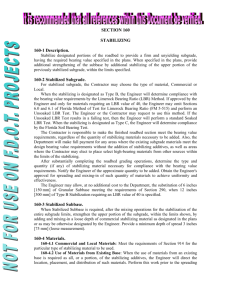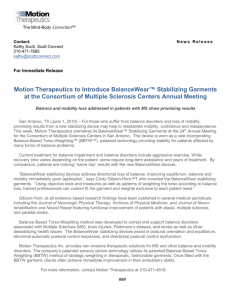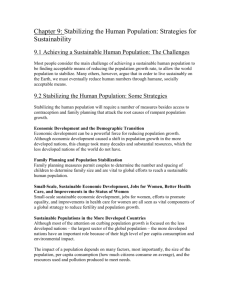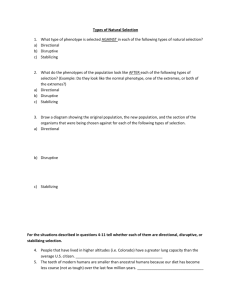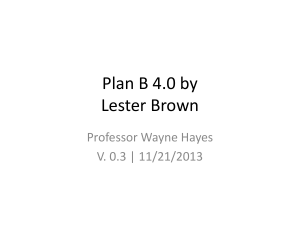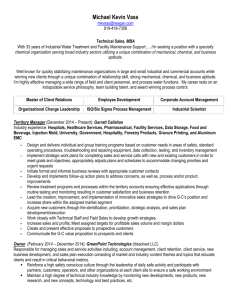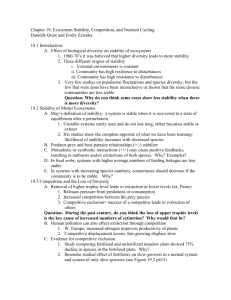section 180 stabilized subbase
advertisement
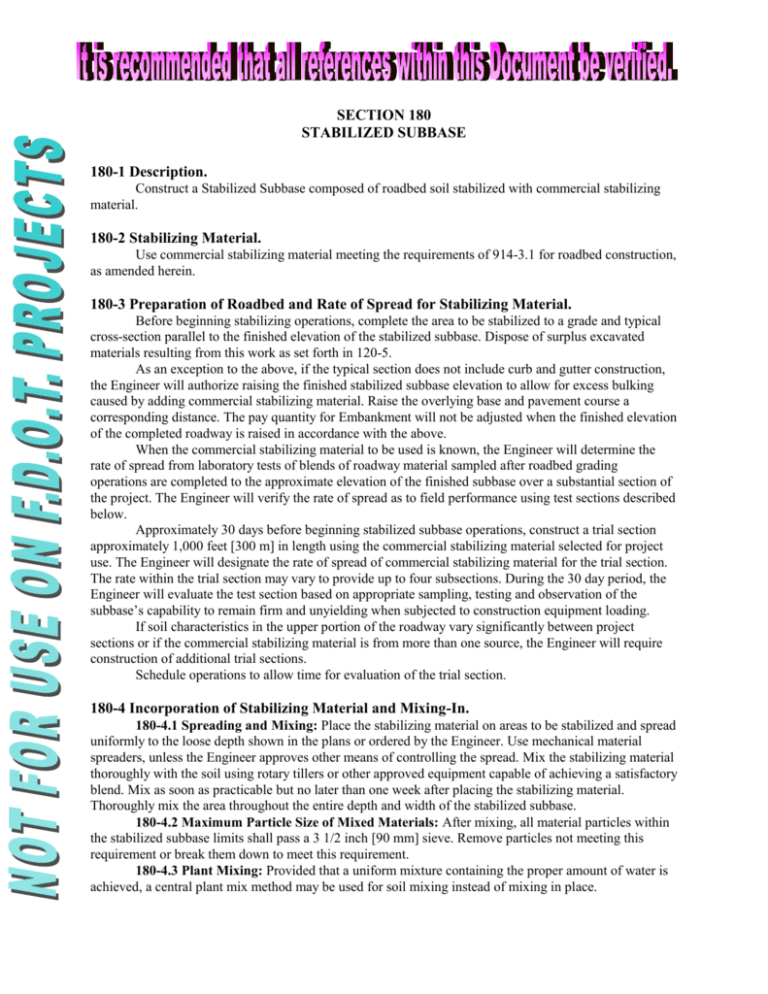
SECTION 180 STABILIZED SUBBASE 180-1 Description. Construct a Stabilized Subbase composed of roadbed soil stabilized with commercial stabilizing material. 180-2 Stabilizing Material. Use commercial stabilizing material meeting the requirements of 914-3.1 for roadbed construction, as amended herein. 180-3 Preparation of Roadbed and Rate of Spread for Stabilizing Material. Before beginning stabilizing operations, complete the area to be stabilized to a grade and typical cross-section parallel to the finished elevation of the stabilized subbase. Dispose of surplus excavated materials resulting from this work as set forth in 120-5. As an exception to the above, if the typical section does not include curb and gutter construction, the Engineer will authorize raising the finished stabilized subbase elevation to allow for excess bulking caused by adding commercial stabilizing material. Raise the overlying base and pavement course a corresponding distance. The pay quantity for Embankment will not be adjusted when the finished elevation of the completed roadway is raised in accordance with the above. When the commercial stabilizing material to be used is known, the Engineer will determine the rate of spread from laboratory tests of blends of roadway material sampled after roadbed grading operations are completed to the approximate elevation of the finished subbase over a substantial section of the project. The Engineer will verify the rate of spread as to field performance using test sections described below. Approximately 30 days before beginning stabilized subbase operations, construct a trial section approximately 1,000 feet [300 m] in length using the commercial stabilizing material selected for project use. The Engineer will designate the rate of spread of commercial stabilizing material for the trial section. The rate within the trial section may vary to provide up to four subsections. During the 30 day period, the Engineer will evaluate the test section based on appropriate sampling, testing and observation of the subbase’s capability to remain firm and unyielding when subjected to construction equipment loading. If soil characteristics in the upper portion of the roadway vary significantly between project sections or if the commercial stabilizing material is from more than one source, the Engineer will require construction of additional trial sections. Schedule operations to allow time for evaluation of the trial section. 180-4 Incorporation of Stabilizing Material and Mixing-In. 180-4.1 Spreading and Mixing: Place the stabilizing material on areas to be stabilized and spread uniformly to the loose depth shown in the plans or ordered by the Engineer. Use mechanical material spreaders, unless the Engineer approves other means of controlling the spread. Mix the stabilizing material thoroughly with the soil using rotary tillers or other approved equipment capable of achieving a satisfactory blend. Mix as soon as practicable but no later than one week after placing the stabilizing material. Thoroughly mix the area throughout the entire depth and width of the stabilized subbase. 180-4.2 Maximum Particle Size of Mixed Materials: After mixing, all material particles within the stabilized subbase limits shall pass a 3 1/2 inch [90 mm] sieve. Remove particles not meeting this requirement or break them down to meet this requirement. 180-4.3 Plant Mixing: Provided that a uniform mixture containing the proper amount of water is achieved, a central plant mix method may be used for soil mixing instead of mixing in place. 180-4.4 Depth of Mixing Stabilizing Material: Mix the stabilizing material to the nominal depth shown in the plans. The following tolerances over or under the specified depth will be allowed: Plan Depth 8 inches [200 mm] or less Over 8 inches [200 mm] Tolerance 1 inch [25 mm] 2 inches [50 mm] If the measured mixing depth is less than the minimum specified above, remix the stabilized subbase until the stabilizing material is distributed throughout the subbase course to the required depth. Where the measured mixing depth exceeds the maximum specified, add 1 inch [25 mm] of stabilizing material (loose measure) for each 1 inch [25 mm] exceeding the allowable depth (but in no case less than 1 inch [25 mm] of material) in the top 6 inches [150 mm] of the subbase. Work or materials to correct the above deficiency will be at no expense to the Department. The Engineer may waive the above remixing requirements or adding stabilizing material and remixing for Stabilized Subbase that serves solely as a working platform for concrete paving equipment, if the original subbase is firm and substantially unyielding. 180-5 Compaction. Shape and compact the subbase after the mixing operations are complete. The minimum density acceptable is 98% of the maximum density determined by AASHTO T 180. Use Test Method D of AASHTO T 180 (as modified by the Department’s Research Bulletin 22-B, Revised April, 1972). The specified density is not required in the upper 6 inches [150 mm] of areas to be grassed. The Engineer may waive the density requirement for Stabilized Subbase that serves solely as a working platform for concrete paving equipment, if the subbase as compacted is firm and substantially unyielding. Compact the materials at a moisture content to allow the specified density be attained. Add water or allow the material to dry to achieve the proper moisture content for adequate compaction. 180-6 Finish Grading. 180-6.1 General: Shape the completed stabilized subbase to conform with the finished lines, grades and cross section indicated in the plans. Check the subbase by using elevation stakes, or other means approved by the Engineer. Do not dispose of surplus excavated materials on shoulders to be grassed or sodded. 180-6.2 Working Platforms for Econocrete Base on Through Lanes: Immediately prior to placing of roadway Econocrete Base, trim the subbase with an automatically controlled subgrade trimming machine, as specified in 350-3.2, to a tolerance of 1/8 inch [3 mm] above or below true grade as established by the taut line set for vertical control of the machine. Trim across the entire width to be paved in each pass of the paving train (including the area on which the slipform paver tracks will operate) in a single pass. The Engineer will check the area of the subbase where the slipform paver tracks will operate for proper elevation by measuring from a stringline stretched across the taut lines placed for vertical control of the subgrade trimming machine. Provide labor necessary to assist in taking such measurements. 180-7 Requirements for Condition of Completed Subbase. After the stabilizing and compacting operations, ensure that the subbase is firm and substantially unyielding to support construction equipment. Remove and replace with a suitable material, all soft and yielding material, and any other portions of the subbase that will not compact readily. Bring the whole subbase to line and grade, with proper allowance for subsequent compaction. 180-8 Maintenance of Completed Subbase. Maintain the completed subbase free from ruts, depressions and any damage resulting from the hauling or handling of materials, equipment, tools, etc. Maintain the required density until the subsequent base is in place. Recompaction will be at no expense to the Department. 180-9 Method of Measurement. The quantity to be paid for will (1) be plan quantity, in square yards [square meters] of stabilized subbase, completed and accepted, and (2) the volume in cubic yards [cubic meters] of commercial stabilizing material, applied on the road and accepted. The quantity of Commercial Stabilizing Material will be determined by measurement in a loose condition, leveled in truck bodies at the placement location. 180-10 Basis of Payment. Prices and payments will be full compensation for all the work in this Section including furnishing, hauling, placing and spreading all stabilizing material, and mixing, compacting, finishing and maintaining the subbase. The costs of necessary excavation below the finished grade of the subbase to place the stabilizing material, and the disposal of all surplus excavation, will also be included. No additional compensation will be made for any of the work or material required to correct over or under depth mixing as specified in 180-4.4. Payment shall be made under: Item No. 180- 70Stabilized Subbase (12 inches) - per square yard. Item No. 2180- 70Stabilized Subbase (300 mm) - per square meter. Item No. 180- 71Commercial Stabilizing Material (Special) - per cubic yard. Item No. 2180- 71Commercial Stabilizing Material (Special) - per cubic meter.
